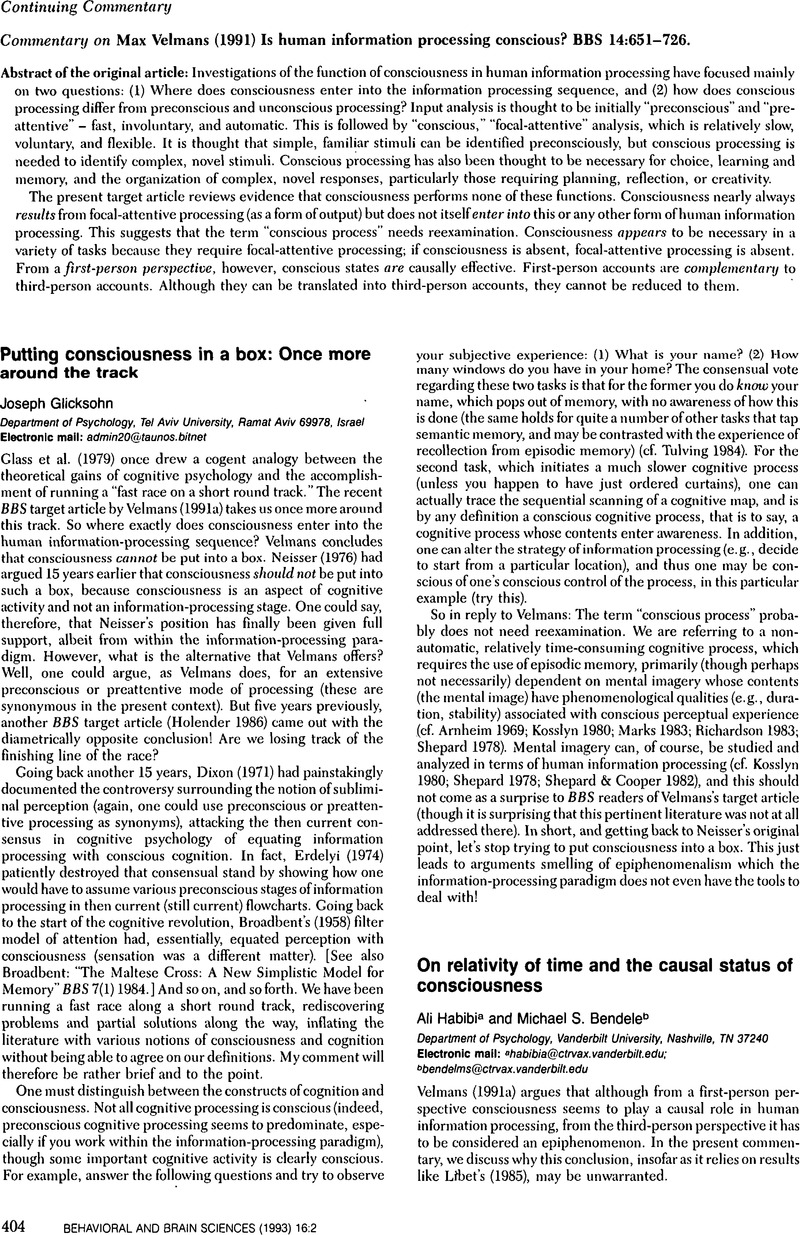Crossref Citations
This article has been cited by the following publications. This list is generated based on data provided by Crossref.
Shames, Victor A.
and
Hubbard, Timothy L.
1995.
Consciousness beyond the comparator.
Behavioral and Brain Sciences,
Vol. 18,
Issue. 4,
p.
697.
Lioyd-Jones, T. J.
Donnelly, N.
and
Weekes, B.
1995.
Correlating mind and body.
Behavioral and Brain Sciences,
Vol. 18,
Issue. 4,
p.
688.
Schmajuk, N. A.
and
Axelrad, E.
1995.
Communication and consciousness: A neural network conjecture.
Behavioral and Brain Sciences,
Vol. 18,
Issue. 4,
p.
695.
Velmans, Max
1995.
The limits of neurophysiological models of consciousness.
Behavioral and Brain Sciences,
Vol. 18,
Issue. 4,
p.
702.
Umiltà, Carlo
and
Zorzi, Marco
1995.
Consciousness does not seem to be linked to a single neural mechanism.
Behavioral and Brain Sciences,
Vol. 18,
Issue. 4,
p.
701.
Gray, Jeffrey A.
1995.
Consciousness and its (dis)contents.
Behavioral and Brain Sciences,
Vol. 18,
Issue. 4,
p.
703.
Foss, Jeffrey
1995.
On seeking the mythical fountain of consciousness.
Behavioral and Brain Sciences,
Vol. 18,
Issue. 4,
p.
682.
Gray, Jeffrey A.
1995.
The contents of consciousness: A neuropsychological conjecture.
Behavioral and Brain Sciences,
Vol. 18,
Issue. 4,
p.
659.
Merskey, Harold
1995.
Comparators, functions, and experiences.
Behavioral and Brain Sciences,
Vol. 18,
Issue. 4,
p.
689.
Newman, James
1995.
Reticular-thalamic activation of the cortex generates conscious contents.
Behavioral and Brain Sciences,
Vol. 18,
Issue. 4,
p.
691.
Swerdlow, Neal R.
1995.
Don't leave the “un” off “consciousness”.
Behavioral and Brain Sciences,
Vol. 18,
Issue. 4,
p.
699.
Ingvaldsen, R. P.
and
Whiting, H. T. A.
1995.
Mind – your head!.
Behavioral and Brain Sciences,
Vol. 18,
Issue. 4,
p.
685.
Toates, Frederick
1995.
On giving a more active and selective role to consciousness.
Behavioral and Brain Sciences,
Vol. 18,
Issue. 4,
p.
700.
Revonsuo, Antti
1995.
Prospects for a cognitive neuroscience of consciousness.
Behavioral and Brain Sciences,
Vol. 18,
Issue. 4,
p.
694.
Eichenbaum, Howard
and
Cohen, Neal J.
1995.
Consciousness, memory, and the hippocampal system: What kind of connections can we make?.
Behavioral and Brain Sciences,
Vol. 18,
Issue. 4,
p.
680.
Díaz, José-Luis
1995.
Hunting for consciousness in the brain: What is (the name of) the game?.
Behavioral and Brain Sciences,
Vol. 18,
Issue. 4,
p.
679.
Lubow, R. E.
1995.
Human consciousness: One of a kind.
Behavioral and Brain Sciences,
Vol. 18,
Issue. 4,
p.
689.
Kinsbourne, Marcel
1995.
Septohippocampal comparator: Consciousness generator or attention feedback loop?.
Behavioral and Brain Sciences,
Vol. 18,
Issue. 4,
p.
687.
Ivanitsky, Alexei M.
1995.
Information synthesis in cortical areas as an important link in brain mechanisms of mind.
Behavioral and Brain Sciences,
Vol. 18,
Issue. 4,
p.
686.
Smith, J. David
1995.
The homunculus at home.
Behavioral and Brain Sciences,
Vol. 18,
Issue. 4,
p.
697.



